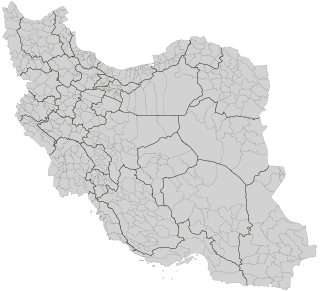
Iran competed at the 2011 World Aquatics Championships in Shanghai, China between July 16 and 31, 2011.

Iran competed at the 2011 World Aquatics Championships in Shanghai, China between July 16 and 31, 2011.
Iran qualified 3 swimmers. [1]
| Athlete | Event | Heats | Semifinals | Final | |||
|---|---|---|---|---|---|---|---|
| Time | Rank | Time | Rank | Time | Rank | ||
| Mohammad Bidarian | Men's 50m Freestyle | 24.33 | 51 | did not advance | |||
| Men's 100m Freestyle | 52.42 | 56 | did not advance | ||||
| Mohammad Alirezaei | Men's 50m Breaststroke | 28.18 | 22 | did not advance | |||
| Men's 100m Breaststroke | DNS | did not advance | |||||
| Saeed Ashtiani | Men's 100m Butterfly | 56.83 | 50 | did not advance | |||
| Men's 200m IM | 2:09.81 | 41 | did not advance | ||||

Azerbaijan, officially the Republic of Azerbaijan, is a transcontinental and landlocked country at the boundary of West Asia and Eastern Europe. It is a part of the South Caucasus region and is bounded by the Caspian Sea to the east, Russia's republic of Dagestan to the north, Georgia to the northwest, Armenia and Turkey to the west, and Iran to the south. Baku is the capital and largest city.

Persian, also known by its endonym Farsi, is a Western Iranian language belonging to the Iranian branch of the Indo-Iranian subdivision of the Indo-European languages. Persian is a pluricentric language predominantly spoken and used officially within Iran, Afghanistan, and Tajikistan in three mutually intelligible standard varieties, respectively Iranian Persian, Dari Persian, and Tajiki Persian. It is also spoken natively in the Tajik variety by a significant population within Uzbekistan, as well as within other regions with a Persianate history in the cultural sphere of Greater Iran. It is written officially within Iran and Afghanistan in the Persian alphabet, a derivative of the Arabic script, and within Tajikistan in the Tajik alphabet, a derivative of the Cyrillic script.

Iran, officially the Islamic Republic of Iran (IRI) and also known as Persia, is a country in West Asia. It borders Turkey to the northwest and Iraq to the west, Azerbaijan, Armenia, the Caspian Sea, and Turkmenistan to the north, Afghanistan to the east, Pakistan to the southeast, the Gulf of Oman and the Persian Gulf to the south. With a multi-ethnic population of about 86 million in an area of 1,648,195 km2 (636,372 sq mi), Iran ranks 17th globally in both geographic size and population. It is the sixth-largest country entirely in Asia and one of the world's most mountainous countries. Officially an Islamic republic, Iran has a Muslim-majority population. The country is divided into five regions with 31 provinces. Tehran is the nation's capital, largest city and financial centre.

The Iran–Iraq War, also known as the First Gulf War, was an armed conflict between Iran and Iraq that lasted from September 1980 to August 1988. Active hostilities began with the Iraqi invasion of Iran and lasted for nearly eight years, until the acceptance of United Nations Security Council Resolution 598 by both sides. Iraq's primary rationale for the attack against Iran cited the need to prevent Ruhollah Khomeini—who had spearheaded the Iranian revolution in 1979—from exporting the new Iranian ideology to Iraq. There were also fears among the Iraqi leadership of Saddam Hussein that Iran, a theocratic state with a population predominantly composed of Shia Muslims, would exploit sectarian tensions in Iraq by rallying Iraq's Shia majority against the Baʽathist government, which was officially secular but dominated by Sunni Muslims. Iraq also wished to replace Iran as the power player in the Persian Gulf, which was not seen as an achievable objective prior to the Islamic Revolution because of Pahlavi Iran's economic and military superiority as well as its close relationships with the United States and Israel.

Ruhollah Musavi Khomeini was an Iranian Islamic revolutionary, politician and religious leader who served as the first supreme leader of Iran from 1979 until his death in 1989. He was the founder of the Islamic Republic of Iran and the main leader of the Iranian revolution, which overthrew Mohammad Reza Pahlavi and ended the Iranian monarchy. Ideologically a Shia Islamist, Khomeini's religious and political ideas are known as Khomeinism.

Shiraz is the fifth-most-populous city of Iran and the capital of Fars province, which has been historically known as Pars and Persis. As of the 2016 national census, the population of the city was 1,565,572 people, and its built-up area with Sadra was home to almost 1,800,000 inhabitants. A census in 2021 showed an increase in the city's population to 1,995,500 people. Shiraz is located in southwestern Iran on the rudkhaneye khoshk seasonal river. Founded in the early Islamic period, the city has a moderate climate and has been a regional trade center for over a thousand years.

Kurdish is a Northwestern Iranian language or group of languages spoken by Kurds in the region of Kurdistan, namely in southeast Turkey, northern Iraq, northwest Iran, and northern Syria. It is also spoken in northeast Iran, as well as in certain areas of Armenia and Azerbaijan.

Tehran is the capital and largest city of Iran. In addition to serving as the capital of Tehran province, the city is the administrative center for Tehran County and its Central District. With a population of around 9.8 million in the city as of 2025, and 16.8 million in the metropolitan area, Tehran is the most populous city in Iran and Western Asia, the second-largest metropolitan area in the Middle East after Cairo, and the 24th most populous metropolitan area in the world. Greater Tehran includes several municipalities, including, Karaj, Andisheh, Eslamshahr, Pakdasht, Qods, and Shahriar.

The history of Iran is intertwined with Greater Iran, a sociocultural region spanning from Anatolia to the Indus River and from the Caucasus to the Persian Gulf. Central to this area is modern-day Iran, which covers the bulk of the Iranian plateau.

The politics of Iran takes place in the framework of an Islamic theocracy which was formed following the overthrow of Iran's millennia-long monarchy by the 1979 Revolution. Iran's system of government (nezam) was described by Juan José Linz in 2000 as combining "the ideological bent of totalitarianism with the limited pluralism of authoritarianism". Although it "holds regular elections in which candidates who advocate different policies and incumbents are frequently defeated", Iran scored lower than Saudi Arabia in the 2021 Democracy Index, determined by the Economist Intelligence Unit.

Iran has a mixed, centrally planned economy with a large public sector. It consists of hydrocarbon, agricultural and service sectors, in addition to manufacturing and financial services, with over 40 industries traded on the Tehran Stock Exchange. With 10% of the world's proven oil reserves and 15% of its gas reserves, Iran is considered an "energy superpower". Nevertheless, since 2024 Iran is suffering from an energy crisis. Also, some allegation were made that Iran manipulates its economic data.

Geography is an important factor in informing Iran's foreign policy. Following the 1979 Iranian Revolution, the newly formed Islamic Republic, under the leadership of Ayatollah Khomeini, dramatically reversed the pro-American foreign policy of the last Shah of Iran Mohammad Reza Pahlavi. Since the country's policies then oscillated between the two opposing tendencies of revolutionary ardour to eliminate non-Muslim Western influences while promoting the Islamic revolution abroad, and pragmatism, which would advance economic development and normalization of relations, bilateral dealings can be confused and contradictory.
The Iran national football team, recognised as IR Iran by FIFA, represents Iran in men's international senior football and is governed by the Football Federation Islamic Republic of Iran (IRI).

The Iranian revolution, also known as the 1979 revolution, or the Islamic revolution of 1979 was a series of events that culminated in the overthrow of the Pahlavi dynasty in 1979. The revolution led to the replacement of the Imperial State of Iran by the present-day Islamic Republic of Iran, as the monarchical government of Mohammad Reza Pahlavi was superseded by the theocratic Ayatollah Ruhollah Khomeini, a religious cleric who had headed one of the rebel factions. The ousting of Pahlavi, the last Shah of Iran, formally marked the end of Iran's historical monarchy.

Ali Hosseini Khamenei is an Iranian cleric and politician who has served as the second supreme leader of Iran since 1989. He previously served as the third president of Iran from 1981 to 1989. Khamenei's 35-year-long rule has made him the longest-serving head of state in the Middle East, as well as the second-longest-serving Iranian leader of the last century after Shah Mohammad Reza Pahlavi. Khamenei is a Grand Ayatollah and marja, and is considered the leader of Shia Muslims and the Axis of Resistance.

The Islamic Revolutionary Guard Corps, also known as the Iranian Revolutionary Guards, is a multi-service primary branch of the Iranian Armed Forces. It was officially established by Ruhollah Khomeini as a military branch in May 1979 in the aftermath of the Iranian Revolution. Whereas the Iranian Army protects the country's sovereignty in a traditional capacity, the IRGC's constitutional mandate is to ensure the integrity of the Islamic Republic. Most interpretations of this mandate assert that it entrusts the IRGC with preventing foreign interference in Iran, thwarting coups by the traditional military, and crushing "deviant movements" that harm the ideological legacy of the Islamic Revolution. Currently, the IRGC is designated as a terrorist organization by Bahrain, Canada, Saudi Arabia, Sweden and the United States.

Iran's counties are administrative divisions of larger provinces (ostan). The word shahrestan comes from the Persian words شهر shahr (city) and ستان stân. "County", therefore, is a near equivalent to شهرستان (šahrestân).

Mahmoud Ahmadinejad is an Iranian principlist and nationalist politician who served as the sixth president of Iran from 2005 to 2013. He is currently a member of the Expediency Discernment Council. He was known for his hardline views and nuclearisation of Iran. He was also the main political leader of the Alliance of Builders of Islamic Iran, a coalition of conservative political groups in the country, and served as mayor of Tehran from 2003 to 2005, reversing many of his predecessor's reforms.

Mohammad Reza Pahlavi, commonly referred to in the Western world as Mohammad Reza Shah, or simply the Shah, was the last monarch of Iran (Persia). In 1941 he succeeded his father Reza Shah and ruled the Imperial State of Iran until 1979 when the Iranian Revolution overthrew him, abolished the monarchy and established the Islamic Republic of Iran. In 1967, he took the title Shahanshah, and also held several others, including Aryamehr and Bozorg Arteshtaran. He was the second and last ruling monarch of the Pahlavi dynasty. His vision of the "Great Civilization" led to his leadership over rapid industrial and military modernization, as well as economic and social reforms in Iran.
Stuxnet is a malicious computer worm first uncovered in 2010 and thought to have been in development since at least 2005. Stuxnet targets supervisory control and data acquisition (SCADA) systems and is believed to be responsible for causing substantial damage to the nuclear program of Iran. Although neither country has openly admitted responsibility, multiple independent news organizations recognize Stuxnet to be a cyberweapon built jointly by the United States and Israel in a collaborative effort known as Operation Olympic Games. The program, started during the Bush administration, was rapidly expanded within the first months of Barack Obama's presidency.